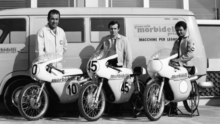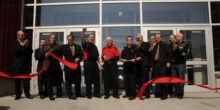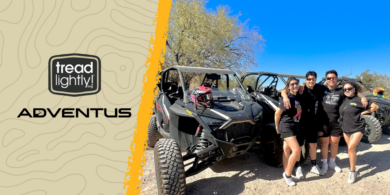These women keep the wheels turning in motorcycling
While women are the fastest growing segment of motorcycling, they still represent just one out of 10 motorcyclists, a relatively small share of the market.
Even smaller is the number of women actually working in the industry. It is still very much a male dominated sector so it may be a surprise to learn that women fill some of the positions responsible for keeping the wheels turning in motorcycling.
The four women profiled below are in charge of ensuring that the rights of motorcyclists, both on road and off road, are not infringed upon. They work silently behind the scenes making sure favorable laws are passed for motorcyclist as well helping to bring continued public awareness to the rights of all bikers.
PAMELA AMETTE
Vice President, MIC
Pamela Amette has worked at the Motorcycle Industry Council (MIC) for 29 years, currently holding the position of vice president of the not-for-profit trade association. Prior to that she worked for three years at Kawasaki Motors Corp. and held positions with the MIC as director of research, as well as research director for the Motorcycle Safety Foundation (MSF) and the Specialty Vehicle Institute of America (SVIA).
Amette says her biggest challenge in meeting the needs of the MIC and accomplishing the group’s goals is finding a unified voice given the diverse interests of its members and the complexity of the issues. She adds, “Fortunately, we’ve been blessed with unselfish, visionary leadership through our board and members that has consistently led the way to the higher ground for the industry as well as the general public.”
When asked what she feels is her biggest accomplishment at the MIC, Amette said, “I was honored to play a key role in laying the foundation for MIC’s industry statistics, including the Motorcycle Statistical Annual, the Retail Sales Report, Retail Outlet Survey, and the highly respected national ownership and usage surveys.
These statistics provide important marketing information to members and are widely used to support media relations and government relations efforts, such as Discover Today’s Motorcycling, Discover Today’s ATV, public land access issues and technical regulations. I’m proud that MIC is regarded as the authoritative source of accurate and timely U.S. industry statistics.”
Most recently, Amette was involved in facilitating the industry’s success in assuring the U.S. Environmental Protection Agency’s adoption of on- and off-highway emissions regulations that will improve air quality benefits without compromising the rider’s experience or adversely impacting market economics.
Amette says the one thing people should know about the MIC that may be not so obvious is the considerable contributions by women to the growing success of the industry.
“Women riders have helped the sport gain broad public acceptance as a form of family recreation,” she says. “And there’s really no position that women can’t aspire to in our industry. Women have been successful in racing, owning and managing dealerships, as editors and publishers of industry publications, and public relations and advertising account executives, to name a few. Women make up at least half of the associate staff here at the MIC, MSF, and SVIA, with many in supervisory positions.”
She adds that government relations can be very intriguing, exciting work that often requires swift action on very complex issues. “You never really know down what paths the ‘art of negotiation’ will take you to reach your goals.”
Amette has ridden on and off highway motorcycles and ATVs during her entire career, although she says she hasn’t ridden in some time because “it’s not as convenient to ride off-highway in Southern California as it used to be.” She has taken the MSF course and the DirtBike School as well as the ATV Safety Institute (ASI) rider course, and highly recommends all three courses to those new to the sport, including “women who want to learn in a fun, non-threatening environment.” n
KATHY VAN KLEEK
Vice President of Government Relations, MIC
Kathy Van Kleeck has also worked at the Motorcycle Industry Council for 29 years and currently holds the title of vice president of government relations. She and her staff are the MIC’s main voice in Washington, DC.
Before holding this position, Van Kleeck held several jobs in the MIC’s government relations office. In her role as vice president, she is responsible for providing overall direction for the MIC’s government relations programs including developing and implementing legislative information programs for the MIC, MSF and SVIA member companies.
She also reviews proposed state and federal legislative and regulatory actions and advocates the associations’ positions to legislators and regulators.
Van Kleeck says the biggest challenge is prioritizing where to concentrate her group’s efforts and instantly addressing whatever issues may emerge.
“In many cases, we don’t set the agenda,” she says. “Our day-to-day agenda is many times set on an hourly basis by which bills are introduced each day, which of them need the most immediate attention and which have the greatest potential to affect the industry for good or ill.”
Legislatures don’t halt their proceedings to wait for MIC input, and state legislation can move through the process very quickly.
“So, if we’re not constantly monitoring the thousands of new bill introductions and immediately preparing our comments, the opportunity to influence the outcome is lost,” she says.
Van Kleeck adds that another big challenge facing the industry is maintaining and expanding off-highway vehicle riding opportunities.
“Not only does this obviously affect the ATV and off-highway motorcycle side of the business, but is of significant value to the entire industry, both OE and aftermarket, since off-road riding is a primary pathway to the on-highway side. It attracts kids to motorcycling and is a key way to bring more women into the sport.”
Having worked her way up through the government relations department at the MIC, Van Kleeck has fine-tuned the way in which the MIC responds to its members needs in regards to legislative issues.
She says her greatest accomplishment thus far is setting up a system of discovery, analysis and corresponding action plan to address the MIC’s members’ government relations needs so that they can feel confident their interests are being protected and promoted and they can focus their attention on running their businesses.
Additionally, she and her staff provide a wide range of information services for member companies, including legislative and regulatory reporting and compilation of comprehensive reference materials.
When asked what one thing she’d like the motorcycle riding public to know about what she and her staff does, she responded: “The majority of government relations isn’t the ‘lobbying’ that the public thinks of. It’s not back room deals and fundraisers (at least not for MIC). It’s a lot of grunt work — investigating, reading, maintaining contact with staff and lots of research to be able to provide accurate and reliable information to both sides.”
Van Kleek is a motorcycle rider, but she says she’s been sidelined since her Honda Express was stolen. n
DANA BELL
Project Coordinator, National Off-Highway Vehicle Conservation Council
Dana Bell worked for six years as the western states representative for the American Motorcyclist Association and served for seven years on the Bureau of Land Management California Desert District Advisory Council. She currently works as the project coordinator for the National Off-Highway Vehicle Conservation Council (NOHVCC). NOHVCC is the group responsible for working with environmental interest groups and land management agencies making sure off-highway enthusiasts have access to public lands.
As project coordinator, Bell says her biggest challenge is bringing these groups together to willingly try to understand each other’s real concerns and to look for solutions that truly address those concerns. She says,
“Collaborations with such diverse public land agencies and land managers have resulted in unique solutions and better long-term opportunity for the OHV public lands.”
This position fits Bell particularly well. She has been a long-time dual-sport competitor and now enthusiast. Bell says working with NOHVCC has allowed her to focus all of her time and energy on educational efforts to promote, enhance and protect responsible off-highway vehicle recreation.
She says the one thing people should know about NOVCC is that it is a non-profit, non-membership organization that focuses all of its work on education. Its primary support is through grants from the Motorcycle Industry Council and Federal Highway Administration Recreational Trails Program, and from OHV Recreation Management Workshop funding by the United States Forest Service and Bureau of Land Management.
Bell rides a 1994 Honda XR250 L dual-sport motorcycle. She says her dream bike for the future is “an out-of-the crate (being severely mechanically-challenged) dual-sport bike with a push button start in the 350 to 400cc range.”
KAREN BOLIN
President, Motorcycle Riders Foundation
Karen Bolin was elected president of the Motorcycle Riders Foundation (MRF), an independent motorcycle rights group, in May 2003. Her term in this volunteer position ends September 2004.
The MRF protects motorcyclists’ rights and freedoms in our nation’s capitol at the grassroots level. It is a membership organization, and unlike the other women profiled here, Bolin and other elected officers are not compensated. Bolin, however, retired from her day job working in retail to concentrate her efforts full-time for the MRF.
As president of the MRF, Bolin’s duties are to direct the board of directors, keeping the group focused in its efforts. The MRF is involved with and monitors a myriad of issues both on the national and international level, including those involving the EPA and proposed emissions standards, discriminatory healthcare benefits to motorcyclists, and the elimination of state rider safety programs due to budget cuts.
When asked what one thing the motorcycling riding public should know about the MRF, Bolin responded, “The MRF board and state representatives are on the move almost every weekend. The group is rooted in various state organizations nationwide. These representatives travel to meetings, events, seminars and runs.” She adds that it is not uncommon for an MRF board member or state representative to be at an event almost every weekend. “Information is key, and motorcyclists absolutely want to know what is happening in the political arena.”
She concludes that a great deal of that time and travel is devoted to organizing “grassroots efforts” which is the MRF.
Bolin has been riding for 15 years. She has two BMWs: a 1986 BMW R65, and a 1995 BMW R100RT Classic, the latter being her favorite. She says, “I love to go out on the road — long days, and long miles. I cannot imagine life without a tank of gas, two wheels and a road.”








